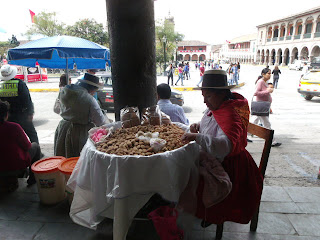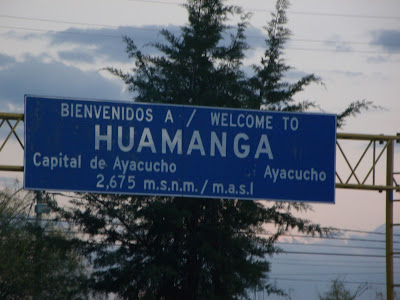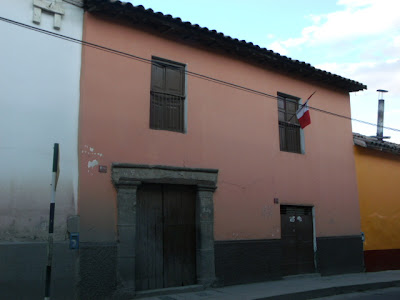Monday, December 24, 2012
Monday, September 10, 2012
Trujillo Toy Museum
In downtown Trujillo, walking distance from the Plaza de Armas, up the street that runs beside the Cathedral and Archbishop's palace on the left, there is the neatest little museum: the Museo del Juguete toy museum.
The museum was started in 1995 by artist Gerardo Chavez, who set out to gather those toys which he had so desired as a child but had been denied. Today the museum houses some 4000 toys from all over the world, from pre-Columbian figurines to electric trains from the 1950s, many of them donations from friends and admirers of the collection.
In seeing the Raggedy Ann doll, I remembered the matching Raggedy Ann and Raggedy Andy my mom sewed Danny and I from a kit when we were little kids.
Many of the toys also reminded me of the ones that had belonged to my brother Toño, which had been lovingly kept safe by his mom, Mama Alvina, and were brought out for me to play with when I visited Ayacucho during summer vacations.
It is well worth a visit, and the toys are sure to bring a smile to one's face if one should ever make it there -they sure did to mine.
Tuesday, August 14, 2012
Ayacucho: Museo Andrés Avelino Cáceres
Two blocks or so from the market and the archway in downtown Huamanga, on Av. 28 de Julio, there is a small Army-run museum dedicated to the memory of Andrés Avelino Cáceres Dorregaray.
Cáceres was a military officer who rose through the ranks, eventually leading the resistance to the Chilean expeditionary forces invading during the War of the Pacific, and subsequently against the government which signed the Treaty of Ancon, which ended the war. For these efforts he is regarded as a national hero, and in his own time came to be regarded as an elder statesman, and was called upon to serve as President on three separate occasions.
In 1919 the government awarded Cáceres the rank of Marshall. He died at Ancon in 1923 at the age of 90.
Though he was born in Huamanga, his home and former estate are in neighboring Huancavelica department. The museum is located in a casona (colonial mansion) that was the home of the Marquis of Mozobamba, and contains some of the Marquis' belongings in addition to items that belonged to Cáceres and others from the period.
 |
| Andrés Avelino Cáceres, wearing the presidential sash |
 |
| Cáceres' epaulets |
 |
| Cáceres' medical kit box, used during the Battle of Acuchimay |
 |
| Cáceres' signature |
 |
| Casona of the Marquis of Mozobamba |
 |
| Funerary effigy of either conquistador Pedro Álvarez Holguín or colonial governor Juan Gutierrez de Quintanilla |
 |
| Colonial painting, of the Ayacucho School, depicting the Last Supper with guinea pig and chapla-like bread |
Museo Andrés Avelino Cáceres
Avenida 28 de Julio #512
Ayacucho, Peru
Tel: +51 066 81 8686
Labels:
Antiquities,
Art,
Ayacucho,
Guinea Pig,
Huamanga,
Museum
Wednesday, August 8, 2012
I've been busy in the last few days and a bit under the weather, which has made my downtime more geared toward rest and recouping rather than blogging. Hence, the dearth of posts in the last week or so.
Anyway, I am nearing the end of my trip, with about three hours to go before I leave for the airport.
I'll catch up on the posting and photos once I'm back in California, plus there are some things I wanted to post but didn't due to the low bandwith and slow transfer rates that we have available here on our dial-up connection.
Ayacucho, Day 3: Pikimachay, Huanta, Luricocha
On the way, the tour stopped at Pikimachay cave.
Pikimachay is across a small valley from the site of Wari, and is noted for having sheltered humans some 17,000 years ago. Making it among the oldest, if not the oldest, human habitation known in the Americas (If I recall correctly, there are two other sites with claims to older human remains, one in Chile and one in Brazil, but both have been seriously questioned and are not wholly accepted within the scientific community.)
Considering the types of fauna whose remains were found alongside the human bones and teeth -animals such as glyptodonts and megatheria- I imagine that the climate of the region was wetter back then than it is now. Today there is no obvious dry-season water supply near the cave and the vegetation is sparse, scrubby, and generally prickly, consisting mainly of cacti, agaves, and molle trees.
 Of those the molles are the friendliest. In Peru the molle is a common shade tree and the small berries it produces are used to make a type of chicha. In the US, where it was introduced by the Spanish, the molle is known as "California pepper tree" on account of the berries, whereas in Mexico it is called "pirul" because of its origins in Peru.
Of those the molles are the friendliest. In Peru the molle is a common shade tree and the small berries it produces are used to make a type of chicha. In the US, where it was introduced by the Spanish, the molle is known as "California pepper tree" on account of the berries, whereas in Mexico it is called "pirul" because of its origins in Peru.The area is so dry that there are few animals, or even birds, visible. One thing that does seem to thrive are insects. In fact, walking around one was made keenly aware of the difficulties farmers must face, for not only is there the aridity, rockyness, and steepness of the land to be dealt with, but there is also no shortage of locusts.
As an illustration, in the image below, taken at the base of Pikimachay hill, there are no fewer than six locusts:
After Pikimachay, the van took us to the town on Huanta.
Huanta is located some 50 kilometers from Huamanga, and is nestled in a green, productive valley, that earned the district the nickname of "Emerald of the Andes."
My family's history with Huanta goes way back. Not only was Mama Pali born there, but her father was at one point mayor and several times member of the town council.
I, myself, hadn't been there since Danny and I took a trip to the city with Mama Pali and her driver, Roman, in about 1973 or 1974. We travelled in my grandparents' old red VW Beetle and carried a litter of kittens to trade and give away along the way. At one point we traded one or two of the cats for a Peruvian naked-neck chicken or qalakunka. The kittens rode in the well of the Bug, but the qalakunka decided to perch on the back seat's backrest, and at every bump and lurch in the unpaved road, the bird flapped its wings wildly to keep its balance, sending feathers everywhere and generally agitating everyone, in addition to shitting all over the back of the car. We arrived at my great-aunt's house in Huanta a lot less put-together than when we left Huamanga, I must say.
This time around, the trip was more sedate.
It being Independence Day weekend, there was to be a bullfight later in the day and the sponsoring committee was out drumming up donations to give away at the event.
After visiting the Plaza of Huanta, we headed down the road to Luricocha district for lunch.
Luricocha is a semi-rural district, with many orchards producing up to 36 varieties of avocado in addition to a host of other fruits and vegetables.
Luricocha district is also known as the hometown of singer and actress Magaly Solier.
At Luricocha we ate at a place called Recreo Hildaria. A recreo is a country establishment with plenty of outdoor areas, often some games available such as a soccer pitch or a fussball table or sapo, and offering hearty local fare. Many are open only on weekends and holidays.
Recreo Hildaria, it turns, out was owned and run by a friend and former schoolmate of several of my younger uncles and aunt, Sr. Ernesto Saenz Jauregui. We had a nice time chatting and catching him up on the news of the family, and meeting him provided a nice ending to a very pleasant day.
Labels:
Andes,
Archaeology,
Ayacucho,
Chicha,
Fauna,
Flora,
Food and Drink,
Guinea Pig,
Historic Sites,
Restaurants
Thursday, August 2, 2012
Ayacucho, Day 2
On our second day in Ayacucho (the 28th of July), I got up early and went down to the corner, to the park in front of San Francisco de Paula church -one of the city's 33 colonial-era churches- and watched people mingle after a wedding and perhaps some baptisms.
The fountain, which has not worked in anyone's memory, was at one time a favourite plaything for my cousins, siblings, and I, who would climb it, hang from it, and clamber into it like a bunch of monkeys. (Somewhere, there's a photo of us in it.)
Susa soon awoke as well, and we ventured down to the plaza for breakfast at the Restaurant Via-Via, in what was once the Hotel Sucre and is now a Belgian-run hotel with the same name as the restaurant.
The food and service at Via-Via are quite good -always cheerful and prompt- and the view from the veranda is great. In the image above, across the Plaza de Armas, one can see the cathedral (consecrated in 1672). Immediately to its right is the palace of Diego Ladron de Guevara (built in 1677), which has long been used as the seat of the University of San Cristobal of Huamanga, and to its left, is City Hall.
Dowstairs, under the archways one can always find ladies dressed in traditional Huamanguina outfits selling old-fashioned treats: cookies and sweet breads, or hand-made icecream.

After walking around downtown for a bit, and sitting in the plaza just people-watching, we wound our way back down to the Alameda for lunch, after which we headed back to the house for a nap and some reading.
In the evening, we went to Lalo's Cafe, a cafe owned by friends of Sara's, at the Centro Cultural San Cristobal, in whose courtyard we afterward watched a presentation of traditional dances from Ayacucho and other regions.
Wednesday, August 1, 2012
Ayacucho, Day 1: Gastronomic Festival
On the first day, after Susana had had a nap and I had gone to breakfast with Pocho, my aunt Betty's brother, Susana and I decided to have lunch at the gastronomic festival that we'd seen advertised all over downtown.
So, after walking down Jiron 28 de Julio, past the market, and then down past the long side wall of the nunnery of Santa Teresa, which still houses a small community of cloistered Carmelite nuns, we arrived at the Alameda, where the festival was being held.
Afterward, we got corraled by a friend of Pocho's who was a few drinks to the wind who insisted that we join him in his orchard for a few beers, and thus we spent our first afternoon in Huamanga.
So, after walking down Jiron 28 de Julio, past the market, and then down past the long side wall of the nunnery of Santa Teresa, which still houses a small community of cloistered Carmelite nuns, we arrived at the Alameda, where the festival was being held.
The Alameda is a pedestrian walk along the Alameda River, bookended by archways. It used to be mostly dirt with some trees, and a set of old swings and one of those spinny things that one pushes, running alongside and then jumping on, and which will send a kid flying off into the dirt if he doesn't hold on while it's spinning. They were great. The swings were so tall that they gave the impression that they were swinging one out over the 30 foot drop to the stony river bed on the other side of the low wall edging the Alameda.
Now, those are gone, and the area has been paved and landscaped with grass and flowers, and a fountain or two. It actually is quite pleasant, if not as exciting for kids as it used to be.
Anyway, the festival was a great success. There were many stands offering a nice sampling of Ayacuchano foods, and lots of people -both Ayacuchanos and visitors- enjoying the offerings. (We, in fact, ate there on two consecutive days.)
 |
| Chicharrones with potatoes |
 |
| Chorizo ayacuchano |
 |
| Triplete of puka picante, chicharrones, spaghetti, beet salad, rice, and teqte |
Afterward, we got corraled by a friend of Pocho's who was a few drinks to the wind who insisted that we join him in his orchard for a few beers, and thus we spent our first afternoon in Huamanga.
Back in Ayacucho
In the predawn hours of the 27th, Susana and I flew to Ayacucho for the Independence Day weekend. Jacho and Diego had been supposed to join us, but they stalled on getting tickets and the prices of them at the last minute, plus the fact that this year it wasn't a 3-day weekend, finally dissuaded them.
We stayed, of course, in the old family 18th Century house on Jiron Garcilazo de la Vega, a block and half from the Plaza de Armas in Huamanga.
We found the house in pretty good shape. The front had been re-plastered and repainted a few years ago, and the roof tiles had been repositioned to close up some gaps that had developed, while the ceilings had also been repainted to repair the spotting caused by the leaks in the roof.
The only issue of note was that the floor of the upper room, which used to be Mama Pali and Papa Ramon's, was cracked and slightly buckled, as a result - I was told- of the 2007 earthquake.
Over the next few days, I'll be posting more about our time in Ayacucho.
Labels:
Air Travel,
Andes,
Architecture,
Ayacucho,
Churches,
Sierra
Subscribe to:
Comments (Atom)






































